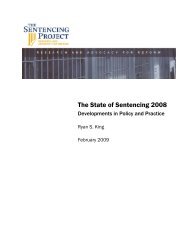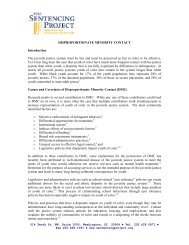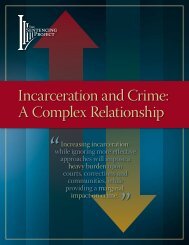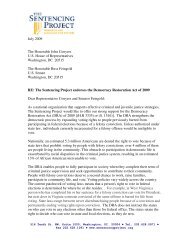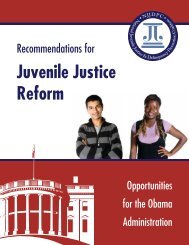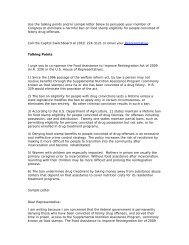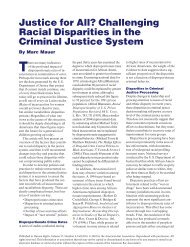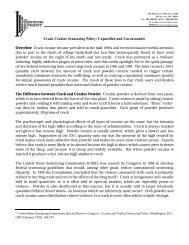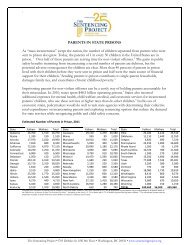view presentation - The Sentencing Project
view presentation - The Sentencing Project
view presentation - The Sentencing Project
You also want an ePaper? Increase the reach of your titles
YUMPU automatically turns print PDFs into web optimized ePapers that Google loves.
Policies & Practices that<br />
Unfairly Shift Youth of<br />
Color into the Juvenile<br />
Justice System<br />
Ashley Nellis, Ph.D.<br />
Research Analyst<br />
<strong>The</strong> <strong>Sentencing</strong> <strong>Project</strong>
How Far Have We<br />
• Part of the federal mandate for 22 years<br />
Come?<br />
• Early federal guidance suggested that DMC would be improved with prevention and<br />
early intervention programming for youth<br />
• States lacked the infrastructure to measure DMC, much less reduce it for some time<br />
• Most states continue to assess DMC but face challenges in connecting causes of DMC<br />
to solutions<br />
• Arrest point remains the least studied decision point<br />
• Outside foundations have provided guidance, support, and assistance to states and<br />
local jurisdictions<br />
• Select local efforts show DMC reductions<br />
• <strong>The</strong> W. Haywood Burns Institute’s work with system stakeholders in Baltimore,<br />
Maryland led to the development of policies that ultimately lowered the number of<br />
youth who were held in secure placement for failure to appear in court. Once a<br />
system was implemented to remind youth of an upcoming court date, the secure<br />
detention of African American youth dropped by almost 50%<br />
<strong>The</strong> <strong>Sentencing</strong> <strong>Project</strong> 2
Commonly Identified<br />
causes of dmc<br />
• Selective enforcement of delinquent behavior<br />
• Differential opportunities for prevention and treatment<br />
• Institutional racism<br />
• Indirect effects of socioeconomic factors<br />
• Differential offending<br />
• Biased risk assessment instruments<br />
• Differential administrative practices<br />
• Unequal access to effective legal counsel<br />
• Legislative policies that disparately impact youth of color<br />
<strong>The</strong> <strong>Sentencing</strong> <strong>Project</strong> 3
Comparison of African American and White Re<strong>presentation</strong><br />
At Various Decision Points in the Juvenile Justice System<br />
<strong>The</strong> <strong>Sentencing</strong> <strong>Project</strong> 4<br />
Data Source: Puzzanchera, C. and Adams, B. (2010). National Disproportionate Minority Contact Databook. Developed<br />
by the National Center for Juvenile Justice for the Office of Juvenile Justice and Delinquency Prevention.
Black : White Relative Rate Indices, 1990-2007<br />
3.0<br />
2.5<br />
2.0<br />
1.5<br />
1.0<br />
0.5<br />
0.0<br />
1990 1991 1992 1993 1994 1995 1996 1997 1998 1999 2000 2001 2002 2003 2004 2005 2006 2007<br />
Arrest Referral Diversion Detention Petition Adjudication Placement Waiver<br />
<strong>The</strong> <strong>Sentencing</strong> <strong>Project</strong> 5<br />
Source: Puzzanchera, C. and Adams, B. (2010). National Disproportionate Minority Contact Databook. Developed by the National Center for Juvenile Justice for the Office of Juvenile Justice and Delinquency Prevention. Data
Black: White Relative Ratio Indices: Arrest Only<br />
<strong>The</strong> <strong>Sentencing</strong> <strong>Project</strong> 6<br />
Source: Puzzanchera, C. and Adams, B. (2010). National Disproportionate Minority Contact Databook. Developed by the National Center for Juvenile Justice for the Office of Juvenile Justice and Delinquency Prevention. Data
Looking Outside the<br />
System<br />
• Most of the work on reducing DMC has focused on issues inside the<br />
system.<br />
• 9 decision points<br />
• Self-report data<br />
• Relative Rate Index (RRI)<br />
• Very little attention is focused on factors outside the system that<br />
unfairly route youth of color to the juvenile justice system.<br />
• Education<br />
• Health<br />
• Mental health<br />
• Substance abuse<br />
• Medical care<br />
• Community support<br />
• Foster care<br />
<strong>The</strong> <strong>Sentencing</strong> <strong>Project</strong> 7
Looking outside the<br />
system<br />
• What policies and practices are operating in your area,<br />
county, or state that unfairly treat youth of color and<br />
lead to a high chance of involvement in the juvenile<br />
justice system?<br />
<strong>The</strong> <strong>Sentencing</strong> <strong>Project</strong> 8
Structural disadvantages create<br />
an uneven playing field<br />
• Acknowledgement that many factors that work to<br />
produce and maintain racial inequities in America today.<br />
• Several aspects of our history and culture that have<br />
allowed the privileges associated with “whiteness” and<br />
the disadvantages associated with “color” to endure and<br />
adapt within the political economy over time.<br />
• It also points out the ways in which public policies,<br />
institutional practices and cultural re<strong>presentation</strong>s<br />
reproduce racially inequitable outcomes.<br />
<strong>The</strong> <strong>Sentencing</strong> <strong>Project</strong> 9
Some Policies outside the juvenile justice<br />
system that unfairly impact youth of<br />
color<br />
• School pushout policies<br />
• Police in schools<br />
• Zero tolerance policies<br />
• Federal housing and welfare bans for those with felony<br />
drug convictions<br />
• Three strikes laws that include juvenile convictions as a<br />
“strike”<br />
• Medicaid termination<br />
<strong>The</strong> <strong>Sentencing</strong> <strong>Project</strong> 10
Police in Schools<br />
• School-based arrests have soared in the past decade, and there are<br />
unclear lines between schools and police about who has the<br />
authority.<br />
• <strong>The</strong> growth of School Resource Officers from 1997 to present has<br />
almost doubled, in part because of federal incentives<br />
• 1997: 9,446 SROs nationwide<br />
• Today: 17,000<br />
• <strong>The</strong> decision about when a student’s conduct becomes criminal is<br />
very subjective.<br />
• <strong>The</strong> presence of police in school disempowers teachers to apply<br />
appropriate discipline<br />
<strong>The</strong> <strong>Sentencing</strong> <strong>Project</strong> 11
Rate of student reported non-fatal<br />
crimes against students (12-18) 18) per 1,000:<br />
1992-2007<br />
2007<br />
12
Who is Watching After<br />
the Students?<br />
5,246 <strong>The</strong> number of law enforcement<br />
officers in public schools in NYC<br />
during the 2008-2009 school year<br />
Vs.<br />
3,152 <strong>The</strong> number of guidance counselors in NYC schools<br />
during the 2008-2009 school year<br />
<strong>The</strong> <strong>Sentencing</strong> <strong>Project</strong> 13
School pushout<br />
• Federal policies<br />
• Gun-Free Schools Act (20 U.S.C. Chapter 70, Sec. 8921)<br />
• Mandates school expulsion for 1 year following referral to<br />
criminal or juvenile court for possession of a weapon.<br />
• Led to quick enactment of similar laws at the state level<br />
• More likely to exist in low-income, inner city schools where<br />
youth of color attend.<br />
<strong>The</strong> <strong>Sentencing</strong> <strong>Project</strong> 14
High school dropouts much more<br />
likely to enter the juvenile justice<br />
system<br />
• One in 10 male high school dropouts between ages of 16<br />
and 24 is incarcerated on any given day<br />
• 68% of prison inmates are high school dropouts<br />
• School engagement is as important if not more<br />
important than school attendance<br />
• Youth of color are more likely to experience an<br />
undiagnosed and untreated learning disability<br />
<strong>The</strong> <strong>Sentencing</strong> <strong>Project</strong> 15
Schools and the<br />
justice system<br />
• What school-related policies can you think of that<br />
contribute to DMC?<br />
<strong>The</strong> <strong>Sentencing</strong> <strong>Project</strong> 16
Foster care system<br />
• More than 500,000 young people are in the foster care<br />
system today<br />
• 37% of all kids in the foster care system are African<br />
American<br />
• Likelihood of entry into foster care as infants is 3 times<br />
higher for African American babies compared to white<br />
babies.<br />
• <strong>The</strong> ages at which disparity is the greatest are infancy<br />
and adolescence (13-17)<br />
<strong>The</strong> <strong>Sentencing</strong> <strong>Project</strong> 17
From Foster Care to<br />
Juvenile Justice<br />
• Connecticut officials estimate 75% of youths in the state's criminal<br />
justice system were once in foster care<br />
• In California, 80% of the adults in in the correctional facilities “are<br />
graduates of the state; the juvenile justice, the child welfare, the<br />
mental health and the special education systems<br />
• A recent study issued by researchers at the University of Chicago<br />
and University of Washington released in May of 2010 found that<br />
nearly 60 percent of young men who had been in foster care had<br />
been convicted of a crime, compared with 10 percent of young men<br />
who had never been in care. For women, three-quarters were on<br />
public assistance by age 24. <strong>The</strong> new study is the largest, and most<br />
comprehensive study of young adults leaving foster care in two<br />
decades.<br />
<strong>The</strong> <strong>Sentencing</strong> <strong>Project</strong> 18
Foster care and the<br />
justice system<br />
• How does the foster care system interact and intersect<br />
with the juvenile justice system in your area?<br />
• What is being done?<br />
• Do the systems communicate with each other?<br />
• Do you know what amount of overlap is between the<br />
two systems?<br />
<strong>The</strong> <strong>Sentencing</strong> <strong>Project</strong> 19
Substance abuse and<br />
treatment<br />
• Black youth drink alcohol much less frequently than white<br />
youth<br />
• According to the National Household Survey on Drug Abuse<br />
(2003), 19.8% of African Americans between ages 12 and 20 used<br />
alcohol in the past 30 days, compared to 31.6% of Whites.<br />
• Almost eleven percent of African American youth reported<br />
“binge” drinking in the past month, compared to 21.7% of<br />
Whites.<br />
• Black youth report approximately that same level of illicit drug<br />
use as white youth<br />
• Non-criminal justice treatment opportunities for black youth<br />
are substantially lower than for white youth<br />
<strong>The</strong> <strong>Sentencing</strong> <strong>Project</strong> 20
Substance abuse and mental<br />
health assistance<br />
• DMC often occurs because of the inappropriate use of<br />
detention to access needed treatment<br />
• Involvement in the juvenile justice system creates<br />
collateral consequences<br />
• Reenrollment in school<br />
• Reinstatement of Medicaid benefits<br />
• Disconnection from peers<br />
• Shame<br />
• Employment barriers<br />
<strong>The</strong> <strong>Sentencing</strong> <strong>Project</strong> 21
Substance abuse, mental health, and<br />
the juvenile justice system<br />
• How many kids who enter the system have mental health<br />
problems? (Depression, Bipolar, etc.)<br />
• How many kids who enter the system have ever been<br />
treated by a psychologist? Been to treatment center for a<br />
substance abuse problem?<br />
• Do the systems communicate with each other? Share<br />
data?<br />
<strong>The</strong> <strong>Sentencing</strong> <strong>Project</strong> 22
solutions<br />
• Racial impact statements: look before you leap<br />
• Strengthen the JJDPA<br />
• Reverse policies and practices that produce DMC<br />
<strong>The</strong> <strong>Sentencing</strong> <strong>Project</strong> 23
Racial impact<br />
statements<br />
• Regardless of cause, disparate racial impact should be avoided. <strong>The</strong> collateral<br />
consequences of unnecessary involvement in the juvenile justice system are<br />
long-standing.<br />
• Similar to environmental impact statements<br />
• Require policymakers to examine all pending legislation and policy changes<br />
with an eye toward possible consequences based on race.<br />
• States that have enacted or will introduce legislation in the coming year:<br />
• Connecticut<br />
• Iowa<br />
• Minnesota<br />
• New York<br />
• Texas<br />
• Oregon<br />
<strong>The</strong> <strong>Sentencing</strong> <strong>Project</strong> 24
Improve the dmc core requirement<br />
• Senate Bill 678 suggests that the DMC core protection should be<br />
strengthened by requiring States to take concrete steps to reduce racial<br />
and ethnic disparities in the juvenile justice system.<br />
• States should be required to:<br />
• Establish coordinating bodies to oversee efforts to reduce disparities;<br />
• Identify key decision points in the system and the criteria by which decisions<br />
are made;<br />
• Create systems to collect local data at every point of contact youth have with<br />
the juvenile justice system (disaggregated by descriptors such as race,<br />
ethnicity and offense) to identify where disparities exist and the causes of<br />
those disparities;<br />
• Develop and implement plans to address disparities that include measurable<br />
objectives for change;<br />
• Publicly report findings; and<br />
• Evaluate progress toward reducing disparities.<br />
<strong>The</strong> <strong>Sentencing</strong> <strong>Project</strong> 25
Reverse disparity causing policies and<br />
practices; enact policies that level the<br />
playing field<br />
• Zero tolerance<br />
• Over-policing in schools<br />
• School pushout<br />
• Indigent defense<br />
• Community-based programming and early interventions<br />
<strong>The</strong> <strong>Sentencing</strong> <strong>Project</strong> 26
information<br />
Ashley Nellis<br />
Research Analyst<br />
anellis@sentencingproject.org<br />
202-628-0871<br />
<strong>The</strong> <strong>Sentencing</strong> <strong>Project</strong><br />
www.sentencingproject.org<br />
<strong>The</strong> <strong>Sentencing</strong> <strong>Project</strong> 27



